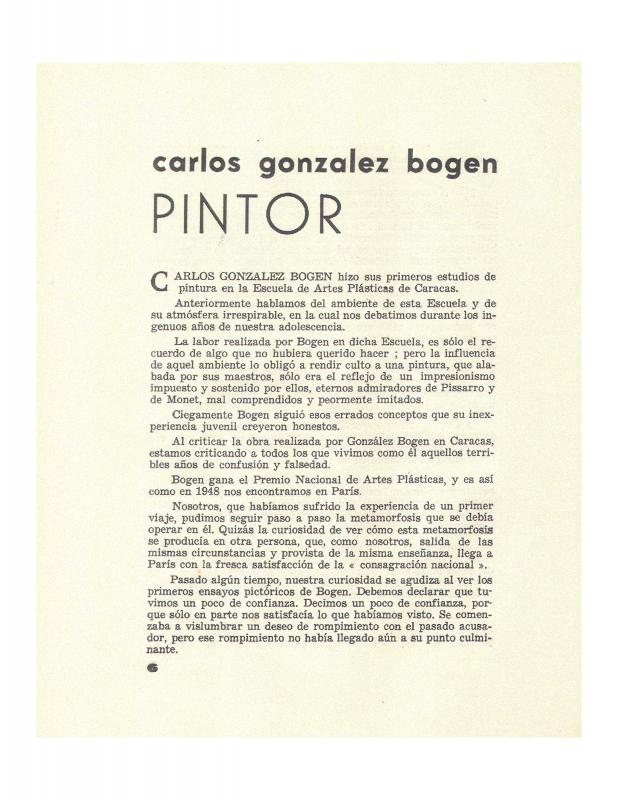Los Disidentes was a group started in Paris in 1950 by a number of Venezuelan artists and writers who lived there from 1945 to 1952. From their home base in Paris they decided to challenge the official education provided by the Escuela de Artes Plásticas de Caracas, which was based specifically on landscape painting and nativist art. In the spirit of their name, Los Disidentes sought to breathe new life into traditional and academic art through an assimilation of the values espoused by European abstraction. The painters in the group included the author of this essay, Alejandro Otero (1921–90) (see also “Del arte abstracto” [doc. no. 813611], “Las ‘placas al mérito’ y la juventud” [doc. no. 813429], “Gastón Diehl promulga y espera una resurrección del espíritu impresionista en Venezuela?” [doc. no. 813625] and “Mateo Manaure en la pintura: Un joven pintor venezolano, en viaje hacia París” [doc. no. 813639]), Pascual Navarro, Luis Guevara Moreno, Carlos González Bogen (“La escuela ‘de los paisajistas’ de Caracas” [doc. no. 813695] and “‘De nuevo’ Los Disidentes” [doc. no. 813667]), Mateo Manaure (“Carlos González Bogen: Pintor” [doc. no. 813583]), Narciso Debourg (“En torno a la pintura de hoy” [doc. no. 813597]), Perán Erminy (“Alrededor de la historia de ‘Los Disidentes’” [doc. no. 813463]), Rubén Núñez, Dora Hersen, and Aimée Battistini, as well as J. R. Guillent Pérez, who was a philosophy student at the time (“Lo latinoamericano y lo occidental [Parte I]” [doc. no. 813723] and “Lo latinoamericano y lo occidental: (Continuación)” [doc. no. 813478]). They were later joined by other Venezuelan artists such as Armando Barrios, Miguel Arroyo, Oswaldo Vigas, Omar Carreño, Alirio Oramas, and Régulo Pérez. They published a magazine, named after the group, Los Disidentes, which carried all their news, and appeared a total of five times.
This article by the painter and theorist Alejandro Otero is important because of its heated counter-criticism of Venezuelan art critics in the mid-twentieth century. His challenge was entirely justified since, at that time, very few people had the required depth of knowledge concerning the problems and difficulties involved in the production of visual arts, or were qualified to understand them and analyze them in order to fully perform their role as art critics. There was, in fact, a very meager tradition of art criticism in Venezuela, and poets and writers had attempted to fill the void by writing descriptions and interpretations that were either lyrical statements or expressions of moral support. Although this solution had sufficed as far as nineteenth-century and anecdotal art were concerned, in Otero’s opinion it was useless as a means of evaluating avant-garde works, proposals, and careers.
Otero’s blunt dismissal of the Venezuelan poet and writer Juan Liscano was part of the typical controversy of the times, and very much in line with the specific objectives of Los Disidentes. Liscano was a staunch defender of tradition, social realism, and folklore, an unacceptable and outdated axiology that was totally at odds with the innovative goals promoted by Los Disidentes.











